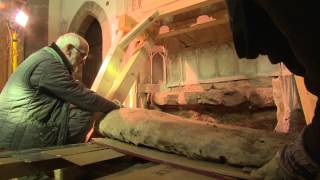 |
| Image from The Scotsman |
In March 2012, a GUARD Archaeology team, led by Maureen Kilpatrick, undertook a rescue excavation when a cist was inadvertently disturbed during landscaping works following the construction of an access track through Cullaird Wood in West Torbreck, south-west of Inverness in Scotland.
The cist, which was capped with a small cairn, contained the remains of a crouched inhumation burial, whose grave goods included seven fragments of flint and a plain Beaker vessel. The burial appeared consistent with a period of use in the early Bronze Age, which has recently been confirmed by radiocarbon dating of 1982-1889 cal BC provided by a sample of the human bones.
Maureen Kilpatrick, who is one of GUARD Archaeology’s Osteoarchaeologists, undertook post-excavation analysis of the human bones recovered from the cist and discovered that these were the remains of an adult female individual who had attained the age of 40 – 44 years at death.
From Herald Scotland:
THE remains of a physically active woman with poor dental hygiene, who died 4000 years ago, have been found.
The discovery, along with others, is said by experts to underline the archaeological significance of the area around Inverness, which was important for prehistoric groups from early times.
Two years ago, a team from GUARD Archaeology, which has bases in Glasgow and Edinburgh, was led by Maureen Kilpatrick to undertake a rescue excavation when a cist, or tomb-like box made of stone, was disturbed during landscaping works for an access track through Cullaird Wood.
The cist contained the remains of a crouched burial, whose grave goods included seven fragments of flint and a plain beaker vessel.
From The Scotsman:
A BRONZE Age grave uncovered in the Highlands has revealed the remains of a woman in her forties who was suffering from toothache before she died 4,000 years ago.
Osteoarchaeologist Maureen Kilpatrick analysed the bones and discovered that they belonged to a woman aged between 40 and 44.
She said: “As the radiocarbon date demonstrates, this occurred at some point between 1982BC and 1889BC.


